In this article:
Calluses are small, thick, hardened tissue with uneven borders occurring on areas of the body that undergo a lot of friction or are under constant pressure. For instance, if you frequently play a string instrument, the constant strumming can make the skin of your fingertips turn thick and form a callus.

Similarly, your feet carry your entire body weight and constantly rub against the floor or footwear when walking or moving. This skin trauma gives rise to calluses on the feet, particularly on the curve of the soles and heels.
This article will take a deep dive into how calluses are formed and how they are treated.
How to Remove Calluses at Home
Here’s a step-by-step procedure to remove calluses at home using mostly natural ingredients:
1. Soften the callus
The first step is to soften the hard, thick skin of the callus so that it becomes easy to scrub off. Here are two simple ways to do that:
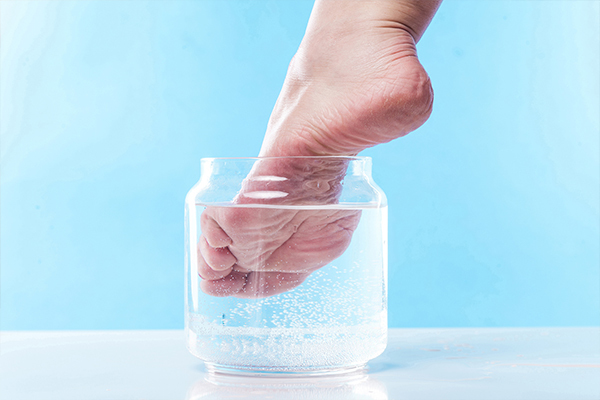
a. Warm saline water soak
Dipping the callus in warm saline water for a short period can help soften the hardened dead skin so that it can be scraped off easily. The salt and gentle heat also help relieve the underlying inflammation and pain to give you instant relief. (1)
How to use:
- Fill a tub or bucket with warm water and mix in a little salt.
- Soak the callus-ridden area into the warm saline solution for 10 minutes or until the hard skin becomes soft. (2)
- Gently rub a soft-bristled brush over the callus to exfoliate the dead skin cells. Do this for a few minutes.
- Wash your skin with clean water.
b. Glycerin and aspirin paste
A combination of glycerin and aspirin makes for a great callus softener. Glycerin lubricates the rough, hard skin and seals in the moisture to keep it soft for longer. (3) Plus, it forms a thick sticky layer over the damaged skin to protect it from infection and friction. (4)
Aspirin contains aminosalicylic acid that helps dissolve the dead skin cells to make them shed faster. This cheap and easily available medication has been used topically for a variety of skin problems and delivered promising results. (5)
However, some users have experienced skin irritation after applying aspirin. Mixing it with glycerin will help make it milder on the skin to avoid such adverse reactions.
How to use:
- Crush 5–6 aspirin tablets into powder form.
- Pour in just enough glycerin to make a thick paste.
- Clean the callus and apply this mixture to the hardened skin.
- Wait for at least 10 minutes or until the paste dries.
- Gently wipe it off with a clean towel soaked in water.
2. Scrub the callus with a pumice stone

Dip the pumice stone in warm water to remove any germs or impurities on its surface. Then, gently rub the stone on the softened callus in circular motions or sideways to file away the dead skin.
Do this for a few minutes and then wash the area with water.
3. Apply a moisturizer
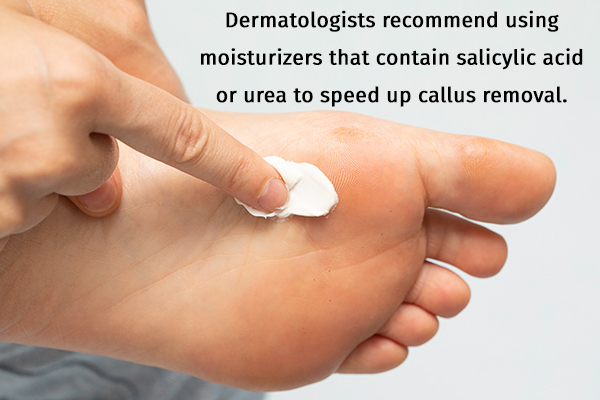
Dermatologists recommend using moisturizers that contain salicylic acid or urea to speed up callus removal. These exfoliating agents help loosen the hardened lesions so that they slough off easily.
But if you are allergic to these ingredients, you can opt for glycerin-based moisturizers or add a bit of glycerin (4) to your regular moisturizer. Glycerin deeply hydrates the skin to make it soft and also speeds up the healing process.
Another natural ingredient that can help hydrate, soften, and repair damaged skin is virgin coconut oil. It is credited with anti-inflammatory, skin-protective, and skin-healing properties. (6) Directly massage a few drops of this oil onto the callus.
4. Use padding in your shoes
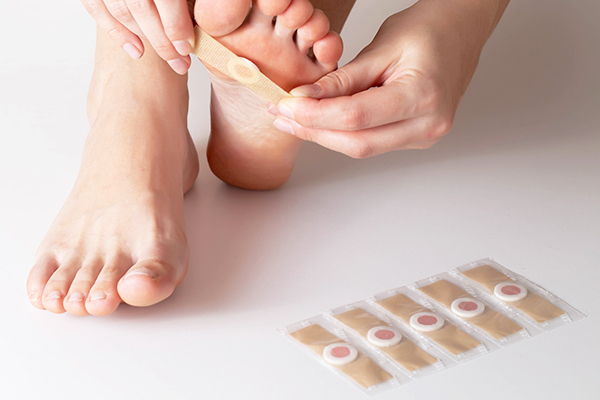
For calluses on the feet, stick semicircle pieces of moleskin tape around the callus. This will act as padding or cushion to absorb any shock, strain, or friction that can further damage or irritate the skin.
Home Remedies to Get Rid of Calluses Naturally
Here are a few other natural ingredients that can help with callus removal:
1. Aloe vera gel
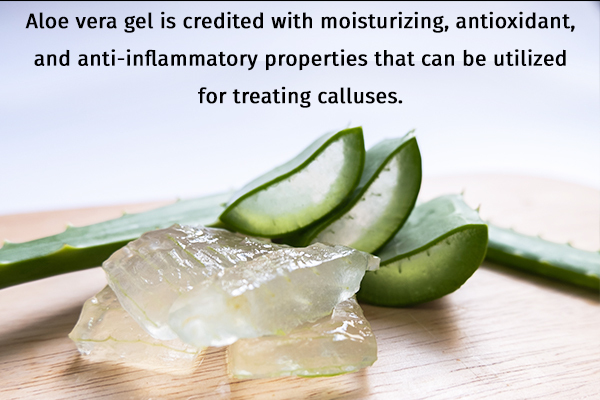
Aloe vera gel is credited with multiple skin-healing properties that can be utilized for treating calluses.
For starters, it has a rich water content, which makes it quite moisturizing. It is also full of antioxidants that help bring down skin inflammation and impart a soothing effect to the gel. (7) Thus, it can help soften the hard exterior of the callus while also relieving the pain and discomfort, at least to an extent.
Plus, its antimicrobial effects help keep infections at bay. This gel was even found effective in treating diabetic foot ulcers. (8)
How to use:
- Cut a small piece of aloe vera leaf and apply the gel side on the callus.
- Apply a bandage over it to keep it in place.
- Leave it overnight.
- Remove the leaf in the morning to reveal a softened callus, which can be easily filed or scrubbed.
Note: If you don’t have an aloe plant at home, use packaged aloe vera gel, but make sure it’s 100% pure.
2. Pineapple peel
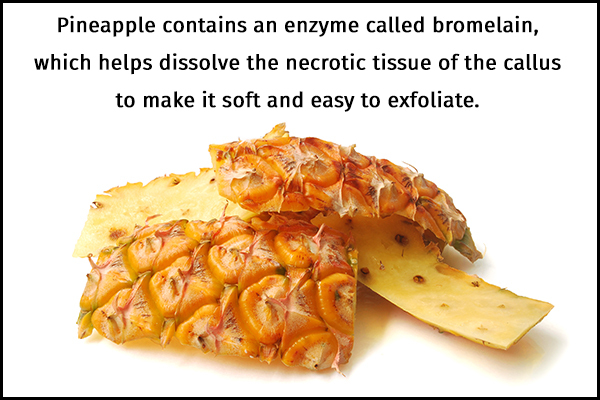
Pineapple contains an enzyme called bromelain, which helps dissolve the necrotic tissue of the callus to make it soft and easy to exfoliate. It also exhibits anti-inflammatory effects (9) that can help bring down the pain and swelling in the lesion.
Moreover, pineapple is full of nutrients with different medicinal properties that can help accelerate skin healing. (10)
How to use:
- Cut a small piece of pineapple peel and tape its fleshy side over the callus for 20 minutes.
- Remove the peel and rub the area with a pumice stone.
- Wash the area with water.
3. Flaxseed oil
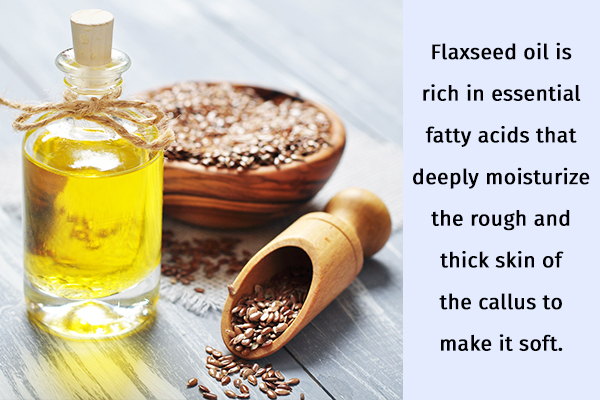
Flaxseed oil is rich in essential fatty acids that deeply moisturize the rough and thick skin of the callus to make it soft. Plus, they work as anti-inflammatory agents that curb the pain and swelling in the area.
This oil also forms a protective layer over the lesion that shields it from further irritation or injury. (11)
How to use:
- Dip your callus-ridden skin in warm water for a few minutes.
- Wait for the skin to dry.
- Wrap a cloth soaked in warm flaxseed oil over it.
- Seal it in place by covering it with cling film.
- Leave it on overnight.
- Remove it the next morning to reveal a softened callus.
4. Castor oil

Castor oil is a thick, viscous lubricant that works great for treating a variety of dry skin conditions. (3) It can also be used for softening the hard skin of calluses.
How to use:
- Mix some liquid soap and castor oil in hot water.
- Keep dipping your pumice stone in this mixture while scrubbing the callus off. Use gentle circular or sideways motion.
Causes Behind Callus Formation
When certain parts of the body repeatedly rub against a hard surface or if they are under excessive strain, the skin in those areas undergoes microtearing. The body tries to protect the damaged skin by forming thick, hard scar tissue over it.
This excess skin acts as a cushion to absorb the strain and as a cover against the injury. These thickened patches of hard, rough skin are known as calluses.
A few common contributing factors to callus formation are:
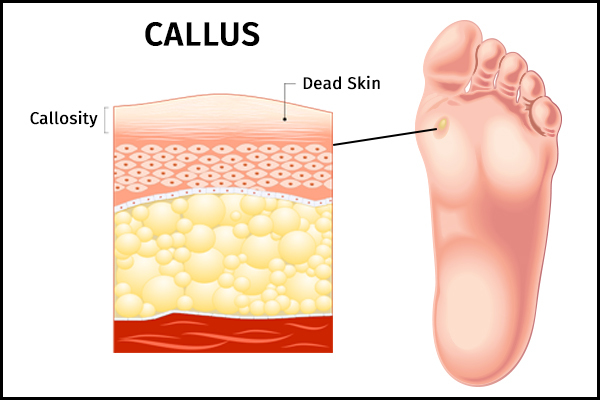
- Wearing footwear that is too tight or too loose or has other structural- or shape-related irregularities
- Performing jobs that require you to stay on your feet for long periods, handle heavy or rough objects, or do a lot of physical labor
- Placing your feet in a certain manner on the ground while walking, standing, or running
- Participating in athletics or sports (12)
- Lifting heavy weights in the gym regularly
- Handling gardening tools
- Doing labor-intensive household chores
Symptoms Associated With Calluses
Calluses form on areas of the body that are under a lot of physical strain or incur repeated mechanical injuries for an extended duration. They generally appear on the lower extremities, but they can also occur on your knees, palms, and fingers.
These lesions tend to be painless at first but can hurt if they continue to grow thicker. The continued strain and friction damage the nerve endings in the area, leading to the development of fluid-filled bursal sacs inside the lesion. The thickened lesions may hurt when touched or pressed.
Treatment for Calluses
The standard medical treatment for calluses is aimed at providing symptomatic relief, minimizing pressure as well as friction on the skin, and removing the hardened dead skin through topical interventions such as callus softeners (13) or, in severe cases, surgery. (14)
Final Word
Calluses are pretty common but do not pose a serious health risk. They often heal on their own, although they can get thicker and harder if subjected to continued friction and pressure. The good thing is most calluses can be safely treated at home under the guidance of a dermatologist.
The above-listed remedies are safe, easy, and inexpensive, but they have to be used properly and consistently to achieve the desired results. If the recommended home treatment does not provide relief and skin healing, consult your doctor for more advanced options.
- Was this article helpful?
- YES, THANKS!NOT REALLY


